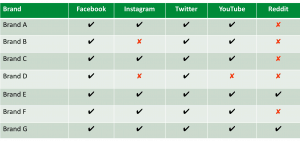
Spinning your wheels on content? What to do next
I hear from more and more marketers who started content marketing but don’t gain the traction they hoped for. Some try to work harder and harder, producing more and more content in more and more media.
But that’s like stepping on the gas when you’re stuck in a snowbank. You just spin your wheels.
You may not need more content. Instead, you may need better insights.
Buyer personas, competitive content audits and all-in analytics reviews help get you unstuck
When your content marketing program gets stuck, here are 3 ways to gain the insights to get it back on the road and win the race against competitors.
1. Gain customer insights with buyer persona research.

Do deep-dive research to define who your buyers are. Learn how they gather information, where they go to get content and how it affects their decisions during the buyer’s journey.
With buyer persona research, you find out which content customers are aware of, which they use and which they value most. Build on this qualitative research with a survey so you can quantify what’s going on beneath the surface.
You may be surprised by the results.
One marketing department was distributing its content through 20 different media vehicles.
But research showed that customers were aware of only 5 of the 20 vehicles. And each customer used only 3 vehicles, on average.
From this research, marketers reworked the content marketing strategy, eliminating half of the existing content vehicles. With fewer vehicles, now they focus on quality, not quantity.
Going forward, each content vehicle will be assigned to do the one job it does best. For example:
- The print magazine will focus on professional topics identified and prioritized by readers, with guidance from an editorial board of subject-matter experts.
- A weekly email will evolve into the definitive source of industrywide news.
- Public relations will deliver a concise, compelling, consistent message to consumers through news media.
- Social media will create content that people share.
2. Learn from competitors with a competitive content audit.
In crowded, competitive markets, take the time to do a thorough competitive content audit.

A competitive content audit encompasses the content universe as seen through a buyers’ eyes – including your content, plus content from a relevant set of influencers and competitors.
You gain clarity on what’s available, which content is relevant and resonant, and who does the best job in each content vehicle.
Most marketers just don’t have the bandwidth to tackle a competitive content audit internally. So they farm out this work.
To find out how competitive your content is, have an objective third party examine your content. Iif you want an impartial view, don’t ask your marketing team or agency to grade their own report cards.
Focus your competitive content audit on finding ways to outsmart competitors. A competitive content audit needs to include:
Search behaviors and trends. Learn:
- Which search terms customers use
- Whether content is well-aligned to search
- What’s trending up and down
- Who’s winning the lion’s share of page-one Google searches
- How search performance varies by geography (state or country).

Brand websites. Find out:
- Which content is working
- Which is not working
- Which ideas are worth copying and improving
- Which content should go into the trashcan
- How each website creates a path to purchase with minimal friction.
News coverage. Do the analysis to see:
- Which companies and products have the greatest share of voice
- Which reporters, reviewers and bloggers are the most influential
- How to improve positive news coverage and share of voice.

Social media. Find out:
- Which kinds of content each competitor offers through mainstream and specialized social media
- Which content gains the most attention, interaction and sharing
- How much content is generated by users and influencers
- Whether social media connects smoothly to the path to purchase
- Which interactions are most valuable
- Which interactions are hurting a brand (for example, offering and then discontinuing customer service on Twitter, or handling haters poorly in public).
E-commerce – Examine products that compete on Amazon and other Internet shops to see:
- How well your products are positioned in each online marketplace
- How many stock keeping units (SKUs) are featured from each brand
- Whether unexpected competitors are showing up.
Those 5 elements are essential to a comprehensive competitive content audit.
When it makes sense, brands add other elements to these 5. For example, brands may need a get a handle on face-to-face customer interactions by extending the audit to include customer experiences such as customer service, retail stores, trade shows and events.

Whenever possible, take advantage of the opportunity to gather your customers’ top questions. What are the 20 most frequently asked customer questions?
“They ask. You answer,” as Marcus Sheridan advises.
Face-to-face, telephone, chat and email interactions enable you to gather the customer questions you need to address through your content. Here’s a way to use customer questions to create great content marketing.
3. Build and test hypotheses from your all-in analytics reviews.
If you don’t have the budget to perform buyer persona research or a competitive content audit, you still can perform regular all-in analytics reviews.
By their nature, all-in analytics reviews can’t offer competitive insights, since they only involve your own content. But such reviews enable you to compare and improve content performance over time.

Gather monthly data on your website, email, public relations, social media, print and event performance for at least the past two years. Show data in the form of a fever chart, so you can see long-terms trends clearly – rather than just looking at snapshots of recent results.
Why do you need two years of data? With 24 months of data, trend lines become more clear and pronounced. By looking at all your content metrics together, you’ll see interactions between media appear:
- Did content peak seasonally?
- Did trade shows drive media coverage?
- Did news coverage drive web traffic?
- Did contests drive user-generated content?
In a 24-month fever chart, peaks and valleys emerge. Seasonality shows. And 24 months of data give you the context to understand what’s going on in any given month.
Assign a dedicated resource to regularly gather your content metrics and build a monthly presentation. Share the metrics regularly with the people who create your content (staff, agencies or freelancers).
Ask your marketing team to individually develop hypotheses about what drove the metrics. Were the peaks and valleys driven by:
- Topics?
- Timing – time of day, day of the week?
- Media type?
- News stories?
- Headlines?
- Formats?
- Seasonality?
- Competitive activity?
- New messaging?
- New products?
- Geographic markets?
Once your team develops competing hypotheses about what’s happening, you can perform experiments and tests to find out which hypotheses are provable. For example, you can A/B test headlines, media types, timing and more.
That’s how all-in analytics reviews enable you to fine-tune your content marketing strategy and editorial calendar, so that your content marketing beats the bad guys more often.
If it feels like you’re spinning your content wheels, take your foot off the gas.
Call a tow truck! Get back on track with buyer persona research, a competitive content audit and all-in analytics reviews.
All three approaches offer new insights to get you back on the road to success.





